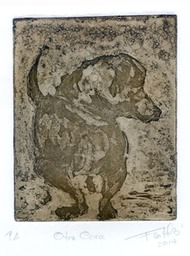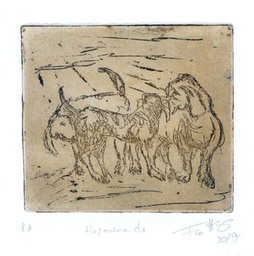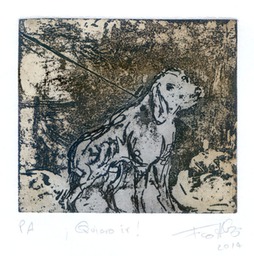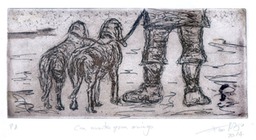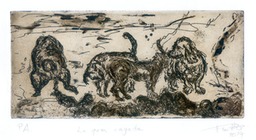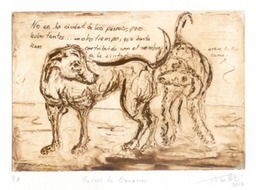
When I was finishing the Electro-etching handbook in the English version in 2012, I sent an email to Francisco Hernández-Chavarria (a master printmaker from Costa Rica) with a chapter I wanted to include as a result of my experiences with electro-etching aluminium plates. These experiments were performed following the instructions of his article “Aguafuerte electrolítico sobre aluminio, hierro y acero” (Electro-etching on aluminium, iron and steel), published in Grabado y Edición, 2011. A process he named sacrificial metal electro-etching*. Francisco replied excited about my article, followed by an email exchange discussing our experiences and evaluating the pros and cons of sacrificial metal electro-etching that took us even a few steps further with electrolytic etching.
We never thought we would personally meet each other. My surprise was that Francisco and his wife Patricia visited Italy and Greece and before going back to Costa Rica they came over to Gran Canaria. It was a pleasure to have them in our residency for a week and a half in October. We had time to do some sightseeing, share long talks and then in the studio practise together those techniques that we were more interested in.
Francisco worked on aluminium plates with acrylic paints and acrylic floor wax varnish to obtain microdot **, with sacrificial metal electro-etching using a power supply of a PC. He practiced lines and microdot with graphite intaglio ink hard ground on iron and aluminium plates. He even did a solar plate etch, a technique that he did not know and was so enthusiastic to the point he would like to find a formula to obtain photopolymer on his own and then make it affordable to the rest of the printmaker community. I wish him luck and that he finds it soon!
From my behalf I appreciate the respect shown by Francisco towards the electro-etching processes I practice, and the number of tricks and formulas that he transmitted me; how to prepare 'limonene' a natural solvent from peel citrus, or how to make the connections of a power supply of a PC for electro-etching. I could understand his way and his interest in safer electro-etching and cheaper metals and recycled materials such as iron and aluminium (as zinc, that is virtually not used in Costa Rica and copper is expensive in most countries). Francisco, who has a great scientist knowledge of the materials, a great interest in experimenting with simple processes and everyday materials, and an enviable ease of communicating results. He has made a great contribution to the community of printmakes. Thank you very much “maestro”.
* The process using sodium chloride as an electrolyte, instead of using an electrolyte of a salt of the same metal to be electro-etched. For more information see the articles Electro-etching Made Easy and The Basis of Electro-etching.
** Fine, printable granulation produced by electrolytic action on the bare surface of the metal on plates etched by electrolysis. An efect similar to traditional aquatint with rosin, a toxic and flammable material.
Pictures from the workshop


Francisco Hernández-Chavarría speaks about his experience in the workshop-residency
After an exhausting European tour with my wife, we arrived at the workshop-studio-laboratory of Alfonso Crujera, at Gran Canaria, which was like finding an oasis of wisdom and learning from the hand of a true master of etching and an experimental scientist.
The stay at that workshop was complemented with the peace, love and the tranquility of a lovely family: Amparo and Alfonso, a beautiful couple, in their stone house built more than a century ago, nestled between two boulder sand framed by a modern bridge, "the bridge", and facing, the roaring waves of the crystalline Atlantic ocean: Sure, was a beautiful oasis!
My visit to Alfonso´s workshop was due to a kind invitation, after exchanging emails about electrolysis, and our worries for the safety of non-toxic printmaking. The aim was to exchange knowledge and opinions. However, I was the most favored, because I learned many important things and ingenious tricks about printmaking, from otherwise inking a plate to an easy way to print several plates in a single paper. Also, I had the opportunity to work in his workshop that is equipped as I never imagined a workshop. Then, the last days I worked as in my house (an improvised workshop), using table salt as universal electrolyte for any metal, and a power supply of a desktop computer, and with metals, such as iron and aluminum; a system that also allows for etching stainless steel and copper: The cheapest way for etching!
Pending work: Evaluation of the safety of the gases liberated, a little bit of hydrogen and chlorine. In my opinion, opening a window is the easiest way to dilute to negligible levels; however, the laboratory tests wait for us.
In summary, we enjoyed a wonderful stay at Gran Canaria, waiting for its completion at Costa Rica.
Francisco Hernández-Chavarría's etching
